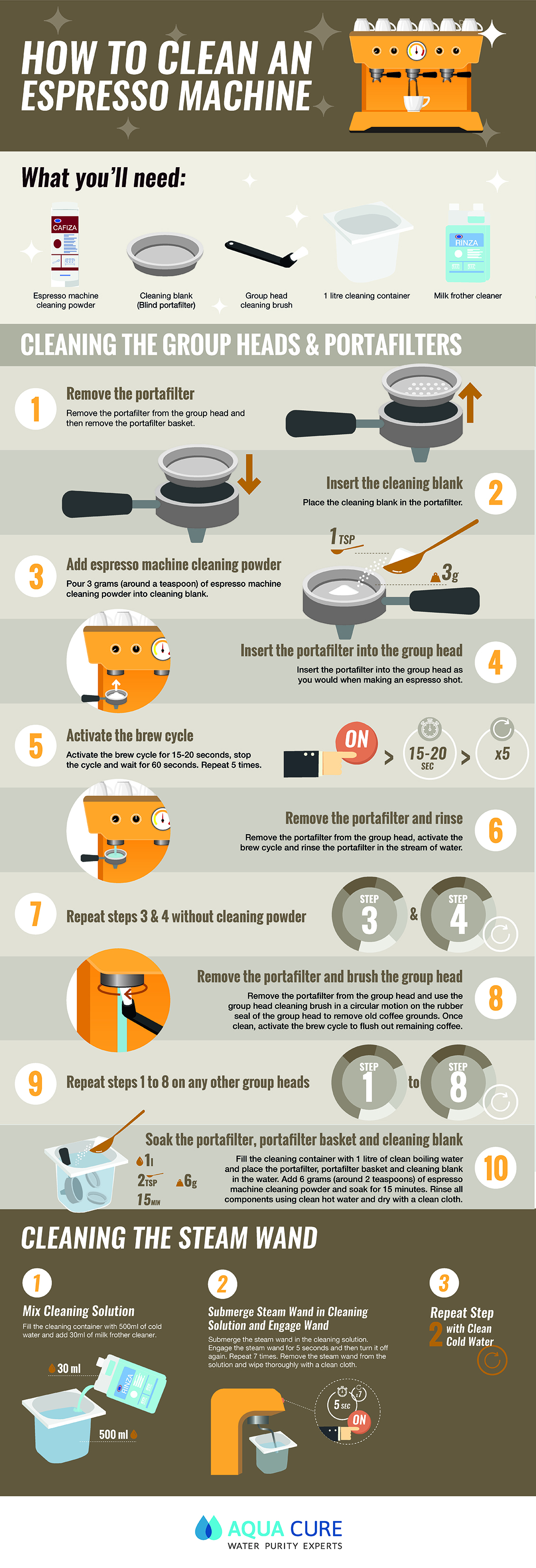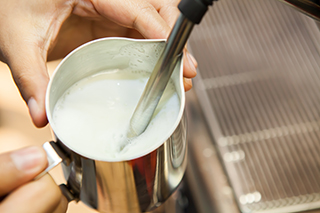We use cookies to make your experience better. To comply with the new e-Privacy directive, we need to ask for your consent to set the cookies. Learn more.
How To Clean An Espresso Machine

Embed This Infographic On Your Site
If you would like to feature this infographic on your site, please use the embed code below. Please include a link to https://www.aquacure.co.uk when you post this. The pixel width of the infographic can also be changed by altering the 'width' pixel value in the code below.
Portafilters and Cleaning Blanks
Cleaning your espresso machine should be done every day. You'll need some espresso machine cleaning powder, a cleaning blank, a group head cleaning brush and a plastic container (ideally with around 1 litre capacity) for soaking your portafilter and basket.
The first step is to remove the portafilter from the group head and then remove the portafilter basket. (The pros use the edge of the cleaning blank to prise the basket out of the group head.)
Fill your plastic container with boiling water and put the basket in to soak. Insert the cleaning blank into the portafilter and pour 1 teaspoon (around 3 grams) of espresso machine cleaning powder into the cleaning blank. Then insert the portafilter into the group head, as you would when making an espresso shot.
Now you can backwash your espresso machine.
Backwashing
A quick note at this point - not all espresso machines have a backwash / backflush facility and some entry level machines lack the necessary 3-way over pressure valve. We recommend consulting your machine's operating manual before attempting a backwash with a cleaning blank.
Assuming your machine allows backwashes, once you've inserted the portafilter with the cleaning blank use the continuous pour button or activate the brew cycle for 15 - 20 seconds. This forces the water and cleaning powder back through the machine in order to clean out any coffee grounds or residue and keep your machine clean and in good working order. After backwashing for 15 -20 seconds, stop and wait a further 60 seconds before repeating the backwash. Repeat this process until you've done at least 5 backwashes.
Remove the portafilter and rinse it clean. Then reinsert the portafilter with the cleaning blank still in place and repeat the backwash, this time without cleaning powder.
Next, remove the portafilter and activate the brew cycle again to flush the group head. Now use the group head cleaning brush to scrub the group head seal and screen / shower plates until you're satisfied that you've removed any leftover coffee or residue and then activate the brew cycle one last time.
Repeat the whole process on any other group heads.
Next, fill your container with 1 litre of boiling water, add two teaspoons of espresso machine cleaning powder (around 6 grams) and put the portafilter, portafilter basket and cleaning blank in to soak. After 15 minutes soaking, take all components back out of the container and rinse them with hot water. You may want to remove your drip tray, empty it and clean it while the portafilter and ancillaries are soaking.
Steam Wands

Lastly, you'll want to clean the steam wand. Fill your container with 500ml of cold water and add 30ml of milk frother cleaner. Submerge your steam wand in the cleaning solution and engage the steam wand for 5 seconds. Repeat this process 7 times before wiping the wand thoroughly with a clean cloth.
Empty out the container and refill with 500ml of cold water. Submerge your steam wand again and engage for 5 seconds to flush out any cleaning solution. Repeat 7 times.
A note of caution when cleaning steam wands - try and minimise the amount of time the steam wand is submerged without being engaged and never soak the steam wand. If the steam wand is submerged for any length of time, it's possible the water can force milk residue back through the steam system and into your boiler. If milk residue gets into your in your boiler, it can quickly go sour, after which any steam produced by your machine may acquire an unpleasant taint which can only be cured by stripping down the machine and cleaning out the boiler.
Summary
Making sure your espresso machine is properly cleaned at the end of each day is vital for both hygiene and in order to keep your machine in working order.
Stray coffee grounds and leftover milk residue will not only harbour bacteria but will impact the flavour of your coffees so if in doubt always give that group head an extra flush and never finish your cleaning regime unless you would be happy to drink a coffee from the machine.
If you have any espresso machine cleaning tips you'd like to share, please feel free to add them in the comments section below.
